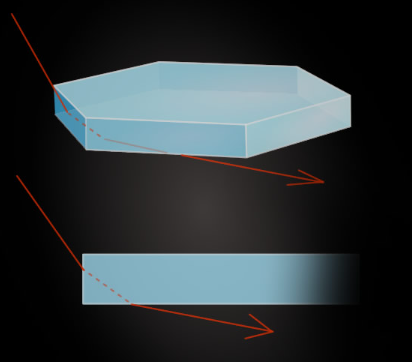OPOD - Moonlight Circumhorizon Arc
Moonlight Circumhorizon Arc: A Stunning Atmospheric Phenomenon
Have you ever gazed at the night sky and been captivated by the ethereal beauty of a lunar halo? These mesmerizing displays are created by a rare atmospheric phenomenon known as the Moonlight Circumhorizon Arc (CHA). In this article, we will delve deeper into the enchanting world of the CHA and explore its unique characteristics.
Understanding the CHA Formation
The CHA is formed by near-horizontal hexagonal plate crystals present in the atmosphere. These crystals refract the moonlight, creating a spectacular arc of colors. Unlike other atmospheric optical phenomena, such as rainbows or halos, the CHA is a rare sight to behold. It occurs when sunlight or moonlight passes through these hexagonal crystals, causing the light to refract at a specific angle.
The Solar and Lunar CHA
While both the solar and lunar CHAs share similar characteristics, there are subtle differences between the two. The solar CHA is predominantly seen during summertime when the sun is higher than approximately 58° in the sky. On the other hand, the lunar CHA is best observed during the northern midwinter when the moon is at its highest point in the sky.
Exploring the Science Behind the CHA
To understand the science behind the CHA, we must delve into the behavior of light as it interacts with the hexagonal plate crystals in the atmosphere. These crystals are inclined at an angle of 90° to each other, allowing for a large angular spread of color. As sunlight or moonlight passes through these crystals, it undergoes refraction, resulting in the mesmerizing display of colors that make up the CHA.
The Role of Hexagonal Plate Crystals
Hexagonal plate crystals play a crucial role in the formation of the CHA. These ice crystals are responsible for refracting the light and creating the distinctive arc of colors. Their unique shape and orientation allow for the dispersion of light at various angles, giving rise to the breathtaking spectacle that is the CHA.
The Influence of Weather Conditions
Weather conditions play a significant role in the visibility of the CHA. Clear skies are essential for optimal viewing, as clouds can obstruct the moonlight and diminish the clarity of the arc. Additionally, atmospheric conditions, such as the presence of ice crystals and their alignment, can impact the intensity and visibility of the CHA.
Capturing the Beauty of the CHA
Photographers and sky enthusiasts alike are often drawn to capturing the ephemeral beauty of the CHA. The arc's vivid colors and striking form make for stunning photographs and unforgettable memories. To capture this phenomenon, one must be in the right place at the right time, with a clear view of the moon and favorable weather conditions.
Appreciating the Rarity of the CHA
The Moonlight Circumhorizon Arc is a rare occurrence, making its sighting all the more special. Its unique combination of atmospheric conditions, crystal alignment, and moon position make it a captivating spectacle to witness. Those fortunate enough to observe this phenomenon are left with a sense of awe and wonder at the intricacies of our atmosphere.
Conclusion
In conclusion, the Moonlight Circumhorizon Arc is a breathtaking atmospheric phenomenon that showcases the beauty and complexity of our natural world. From the unique hexagonal plate crystals to the influence of weather conditions, every element plays a part in creating this enchanting display of colors. So, keep your eyes on the sky, for you never know when you might catch a glimpse of this elusive celestial masterpiece.

Lunar Halo
Christophe Suarez (photography) caught this magnificent lunar circumhorizon arc during a freezing cold night in the Alps. Orion is visible above the arc ©Christophe Suarez, shown with permission.

Near horizontal hexagonal plate crystals produce the huge circumhorizon arc (CHA). Rays are refracted between facets inclined 90° to each other with a resulting large angular spread of colour.
The solar CHA is a summertime halo as the sun must be higher than ~58°.
In contrast, the lunar CHA is best in the northern midwinter when the near full moon is at its highest.
Note: this article has been automatically converted from the old site and may not appear as intended. You can find the original article here.
Reference Atmospheric Optics
If you use any of the definitions, information, or data presented on Atmospheric Optics, please copy the link or reference below to properly credit us as the reference source. Thank you!
-
<a href="https://atoptics.co.uk/blog/opod-moonlight-circumhorizon-arc/">OPOD - Moonlight Circumhorizon Arc</a>
-
"OPOD - Moonlight Circumhorizon Arc". Atmospheric Optics. Accessed on December 18, 2024. https://atoptics.co.uk/blog/opod-moonlight-circumhorizon-arc/.
-
"OPOD - Moonlight Circumhorizon Arc". Atmospheric Optics, https://atoptics.co.uk/blog/opod-moonlight-circumhorizon-arc/. Accessed 18 December, 2024
-
OPOD - Moonlight Circumhorizon Arc. Atmospheric Optics. Retrieved from https://atoptics.co.uk/blog/opod-moonlight-circumhorizon-arc/.